Antenna Array Design Based on Low-Temperature Co-Fired Ceramics
Abstract
:1. Introduction
2. Materials and Methods
2.1. Design of Substrate-Integrated Waveguide Feeding Network
2.2. Antenna Array Design
2.2.1. Antenna Unit Design
2.2.2. Array Simulation and Optimization
2.2.3. Interface Transition Structure Design
3. Results and Discussion
4. Conclusions
Author Contributions
Funding
Data Availability Statement
Acknowledgments
Conflicts of Interest
References
- Dainelli, C.; Fern, M.; De Fazio, A.; Ricci, L.; Ruggieni, M. W band communication link, design and on ground experimentation. In Proceedings of the 2005 IEEE Aerospace Conference, Big Sky, MT, USA, 5–12 March 2005; pp. 920–926. [Google Scholar] [CrossRef]
- Bai, X.; Qu, S.-W.; Ng, K.-B.; Chan, C.H. Sinusoidally Modulated Leaky-Wave Antenna for Millimeter-Wave Application. IEEE Trans. Antennas Propag. 2016, 64, 849–855. [Google Scholar] [CrossRef]
- Manohar, V.; Kovitz, J.M.; Rahmat-Samii, Y. Synthesis and Analysis of Low Profile, Metal-Only Stepped Parabolic Reflector Antenna. IEEE Trans. Antennas Propag. 2018, 66, 2788–2798. [Google Scholar] [CrossRef]
- Ghassemi, N.; Wu, K. Millimeter-Wave Integrated Pyramidal Horn Antenna Made of Multilayer Printed Circuit Board (PCB) Process. IEEE Trans. Antennas Propag. 2012, 60, 4432–4435. [Google Scholar] [CrossRef]
- Kumar, P.; Kedar, A.; Singh, A.K. Design and Development of Low-Cost Low Sidelobe Level Slotted Waveguide Antenna Array in X-Band. IEEE Trans. Antennas Propag. 2015, 63, 4723–4731. [Google Scholar] [CrossRef]
- Kadri, I.; Petosa, A.; Roy, L. Ka-band Fresnel lens antenna fed with an active linear microstrip patch array. IEEE Trans. Antennas Propag. 2005, 53, 4175–4178. [Google Scholar] [CrossRef]
- Hu, J.; Hao, Z.-C.; Wang, Y. A Wideband Array Antenna With 1-Bit Digital-Controllable Radiation Beams. IEEE Access 2018, 6, 10858–10866. [Google Scholar] [CrossRef]
- Hu, J.; Hao, Z.-C. A Compact Polarization-Reconfigurable and 2-D Beam-Switchable Antenna Using the Spatial Phase Shift Technique. IEEE Trans. Antennas Propag. 2018, 66, 4986–4995. [Google Scholar] [CrossRef]
- Hao, Z.-C.; Hong, W.; Chen, J.-X.; Chen, X.-P.; Wu, K. Compact super-wide bandpass substrate integrated waveguide (SIW) filters. IEEE Trans. Microw. Theory Tech. 2005, 53, 2968–2977. [Google Scholar] [CrossRef]
- Wu, Y.-W.; Hao, Z.-C.; Tao, M.-C.; Wang, X.; Hong, J.-S. A Simple and Accurate Method for Extracting Super Wideband Electrical Properties of the Printed Circuit Board. IEEE Access 2019, 7, 57321–57331. [Google Scholar] [CrossRef]
- Singh, M.P.; Mishra, P.; Hirokawa, J.; Ghosh, S. SIW-based Circularly Polarized Slot Antenna Array for Millimeter-Wave Applications. In Proceedings of the 2022 IEEE Microwaves, Antennas, and Propagation Conference (MAPCON), Bangalore, India, 13–16 December 2022; pp. 1318–1322. [Google Scholar] [CrossRef]
- Cui, Y.; Wang, X.; Shen, G.; Li, R. A Triband SIW Cavity-Backed Differentially Fed Dual-Polarized Slot Antenna for WiFi/5G Applications. IEEE Trans. Antennas Propag. 2020, 68, 8209–8214. [Google Scholar] [CrossRef]
- Yin, F.-T.; Liu, J.-Y.; Deng, H.-W.; Liao, T.-Q.; Zuo, C.-Y. A Dual Band Structure-Shared Microstrip Patch Antenna with SIW Cavity-Backed Slot Array. In Proceedings of the 2023 IEEE 11th Asia-Pacific Conference on Antennas and Propagation (APCAP), Guangzhou, China, 22–24 November 2023; pp. 1–2. [Google Scholar] [CrossRef]
- Xie, H.; Li, X.; Xu, Y.; Wu, B. Compact SIW Bow-Tie Slot Filtering Antenna with Low Cross-Polarization. In Proceedings of the 2021 International Conference on Microwave and Millimeter Wave Technology (ICMMT), Nanjing, China, 23–26 May 2021; pp. 1–3. [Google Scholar] [CrossRef]
- Hao, Q.; Zheng, S.; Lu, K. An SIW Horn Antenna With Flat-Top Beam for Millimeter-Wave Applications. IEEE Antennas Wirel. Propag. Lett. 2024, 23, 608–612. [Google Scholar] [CrossRef]
- Segura-Gómez, C.; Palomares-Caballero, Á.; Padilla, P. Efficient Design of H-Plane SIW Horn Antenna Array at mmWaves. In Proceedings of the 2022 16th European Conference on Antennas and Propagation (EuCAP), Madrid, Spain, 27 March–1 April 2022; pp. 1–4. [Google Scholar] [CrossRef]
- Segura-Gómez, C.; Palomares-Caballero, Á.; Alex-Amor, A.; Valenzuela-Valdés, J.; Padilla, P. Design of Compact H-plane SIW antenna at Ka band. In Proceedings of the 2020 14th European Conference on Antennas and Propagation (EuCAP), Copenhagen, Denmark, 15–20 March 2020; pp. 1–4. [Google Scholar] [CrossRef]
- Guan, D.-F.; Ding, C.; Qian, Z.-P.; Zhang, Y.-S.; Cao, W.-Q.; Dutkiewicz, E. An SIW-Based Large-Scale Corporate-Feed Array Antenna. IEEE Trans. Antennas Propag. 2015, 63, 2969–2976. [Google Scholar] [CrossRef]
- Han, W.; Yang, F.; Ouyang, J.; Yang, P. Low-Cost Wideband and High-Gain Slotted Cavity Antenna Using High-Order Modes for Millimeter-Wave Application. IEEE Trans. Antennas Propag. 2015, 63, 4624–4631. [Google Scholar] [CrossRef]
- Asaadi, M.; Sebak, A. High-Gain Low-Profile Circularly Polarized Slotted SIW Cavity Antenna for MMW Applications. IEEE Antennas Wirel. Propag. Lett. 2017, 16, 752–755. [Google Scholar] [CrossRef]
- Yuan, Q.; Hao, Z.-C.; Fan, K.-K.; Luo, G.Q. A Compact W-Band Substrate-Integrated Cavity Array Antenna Using High-Order Resonating Modes. IEEE Trans. Antennas Propag. 2018, 66, 7400–7405. [Google Scholar] [CrossRef]
- Cao, J.; Wang, H.; Mou, S.; Soothar, P.; Zhou, J. An Air Cavity-Fed Circularly Polarized Magneto-Electric Dipole Antenna Array with Gap Waveguide Technology for mm-Wave Applications. IEEE Trans. Antennas Propag. 2019, 67, 6211–6216. [Google Scholar] [CrossRef]
- Suman, K.K.; Kumari, T.; Gangwar, R.K.; Gangwar, V.S. High-Gain SIW Antenna with Ridge Gap Waveguide Feed for W-Band Applications. In Proceedings of the 2023 IEEE Microwaves, Antennas, and Propagation Conference (MAPCON), Ahmedabad, India, 11–14 December 2023; pp. 1–4. [Google Scholar] [CrossRef]
- Munir, A.; Syihabuddin, B.; Maulana, M.F.; Aulia, R. Characterization of A 3D-Printed PLA-Based Slotted SIW Antenna. In Proceedings of the 2023 Workshop on Microwave Theory and Technology in Wireless Communications (MTTW), Riga, Latvia, 4–6 October 2023; pp. 128–131. [Google Scholar] [CrossRef]
- Pandit, S.; Abegaonkar, M.P.; Basu, A. SIW Cavity Backed High-Gain Slot Antenna using Metamaterial for 5G mmWave Communications. In Proceedings of the 2022 IEEE Microwaves, Antennas, and Propagation Conference (MAPCON), Bangalore, India, 12–16 December 2022; pp. 1130–1133. [Google Scholar] [CrossRef]
- Zhang, T.; Li, L.; Zhu, Z.; Cui, T.J. A Broadband Planar Balun Using Aperture-Coupled Microstrip-to-SIW Transition. IEEE Microw. Wirel. Compon. Lett. 2019, 29, 532–534. [Google Scholar] [CrossRef]
- Wu, Y.-W.; Hao, Z.-C.; Miao, Z.-W. A Planar W-Band Large-Scale High-Gain Substrate-Integrated Waveguide Slot Array. IEEE Trans. Antennas Propag. 2020, 68, 6429–6434. [Google Scholar] [CrossRef]
- Xiao, J.; Li, X.; Qi, Z.; Zhu, H. 140-GHz TE340-Mode Substrate Integrated Cavities-Fed Slot Antenna Array in LTCC. IEEE Access 2019, 7, 26307–26313. [Google Scholar] [CrossRef]
- Wang, X.-C.; Yu, C.-W.; Qin, D.-C.; Lu, W.-Z. W-Band High-Gain Substrate Integrated Cavity Antenna Array on LTCC. IEEE Trans. Antennas Propag. 2019, 67, 6883–6893. [Google Scholar] [CrossRef]
- Teng, L.; Yu, Z.-J.; Zhu, D.-L. Millimeter wave-terahertz substrate integrated waveguide transition structure based on low temperature co-fired ceramic. Acta Phys. Sin. 2022, 71, 378–388. [Google Scholar] [CrossRef]
- Lamminen, A.E.I.; Saily, J.; Vimpari, A.R. 60-GHz Patch Antennas and Arrays on LTCC With Embedded-Cavity Substrates. IEEE Trans. Antennas Propag. 2008, 56, 2865–2874. [Google Scholar] [CrossRef]
- Cao, B.; Wang, H.; Huang, Y.; Zheng, J. High-Gain L-Probe Excited Substrate Integrated Cavity Antenna Array with LTCC-Based Gap Waveguide Feeding Network for W-Band Application. IEEE Trans. Antennas Propag. 2015, 63, 5465–5474. [Google Scholar] [CrossRef]
- Cao, Z.; Liu, Z.; Meng, H.; Dou, W. Design of W-band Microstrip Antenna Array. In Proceedings of the 2019 IEEE Asia-Pacific Microwave Conference (APMC), Singapore, 10–13 December 2019; pp. 1319–1321. [Google Scholar] [CrossRef]
- Xu, J.; Chen, Z.N.; Qing, X.; Hong, W. 140-GHz Planar Broadband LTCC SIW Slot Antenna Array. IEEE Trans. Antennas Propag. 2012, 60, 3025–3028. [Google Scholar] [CrossRef]
- Wang, D.; Fan, Y.; Cheng, Y.J. A W-Band, Low-Cost and High-Efficiency Antenna Array Using Multilayer SIW-to-SIW Transition with Leakage-Suppressing Scheme. IEEE Trans. Antennas Propag. 2023, 71, 10014–10019. [Google Scholar] [CrossRef]
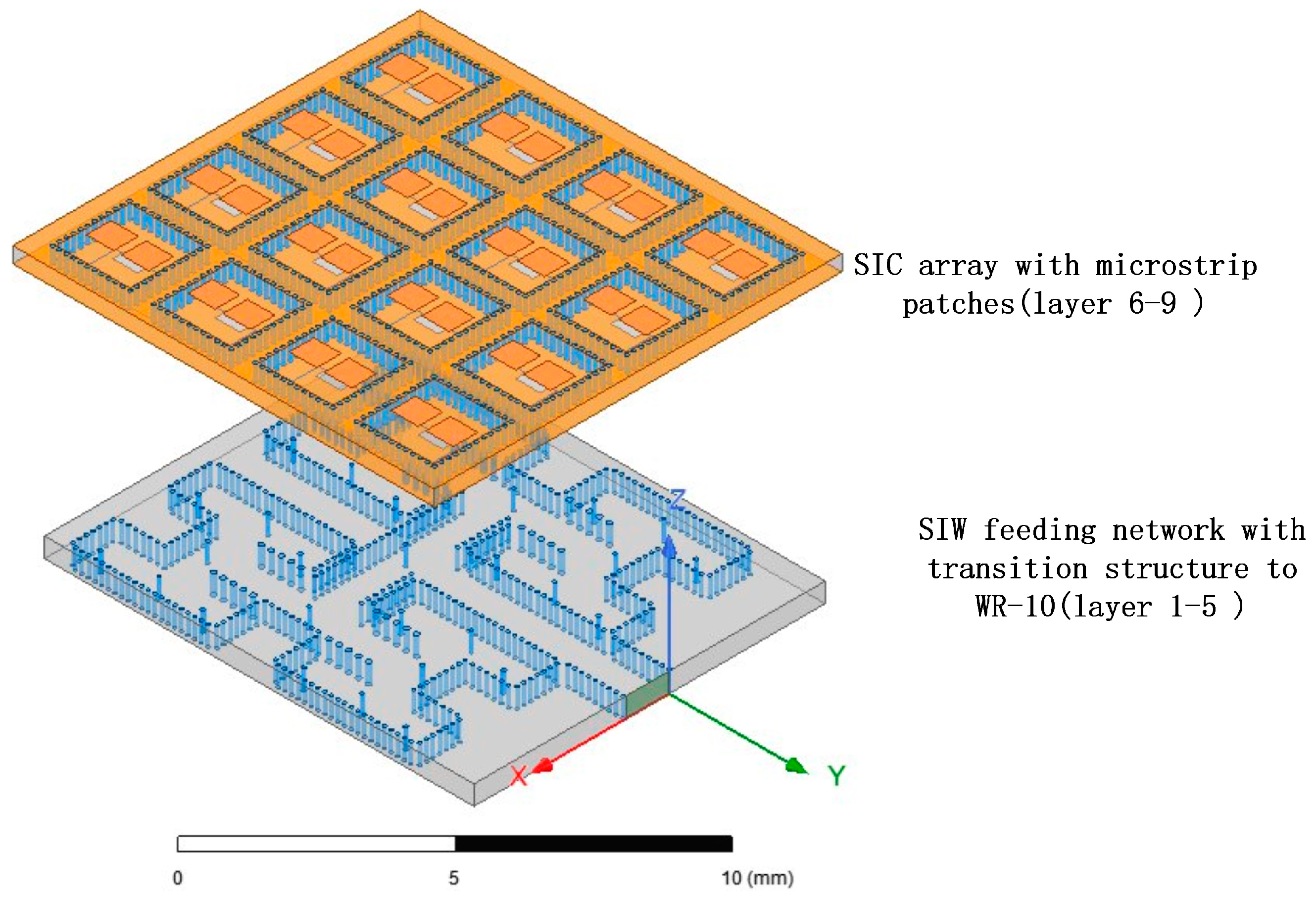
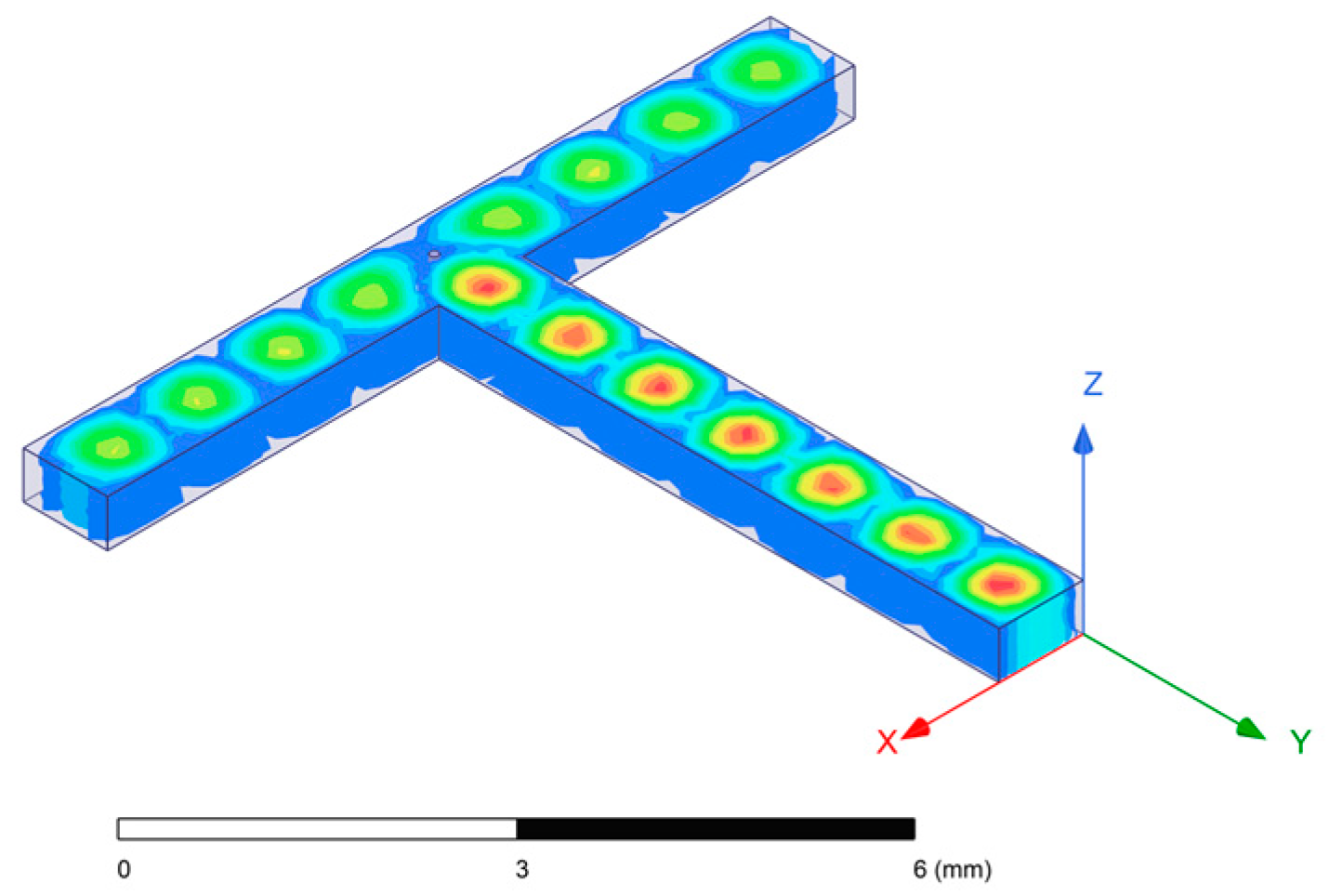

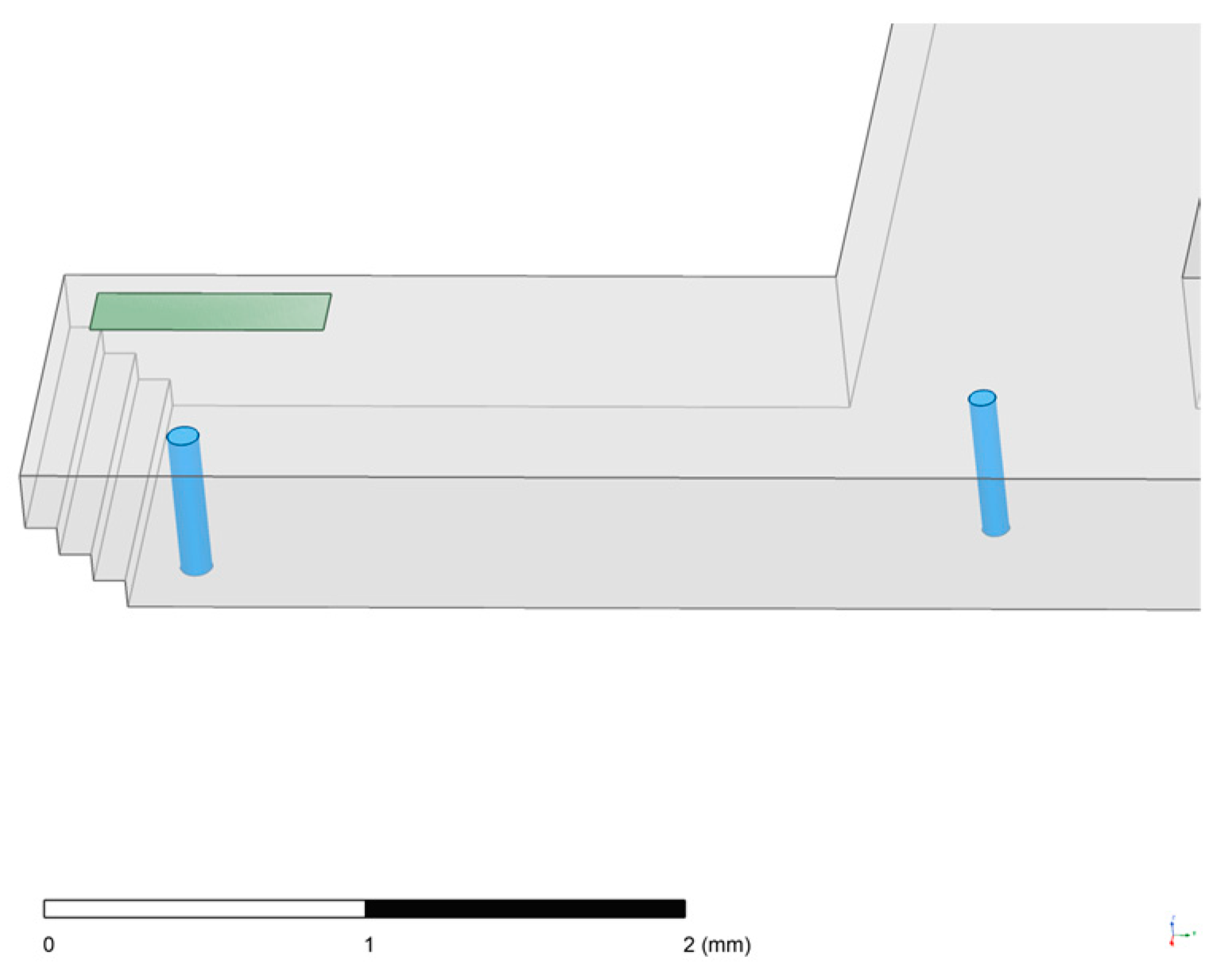

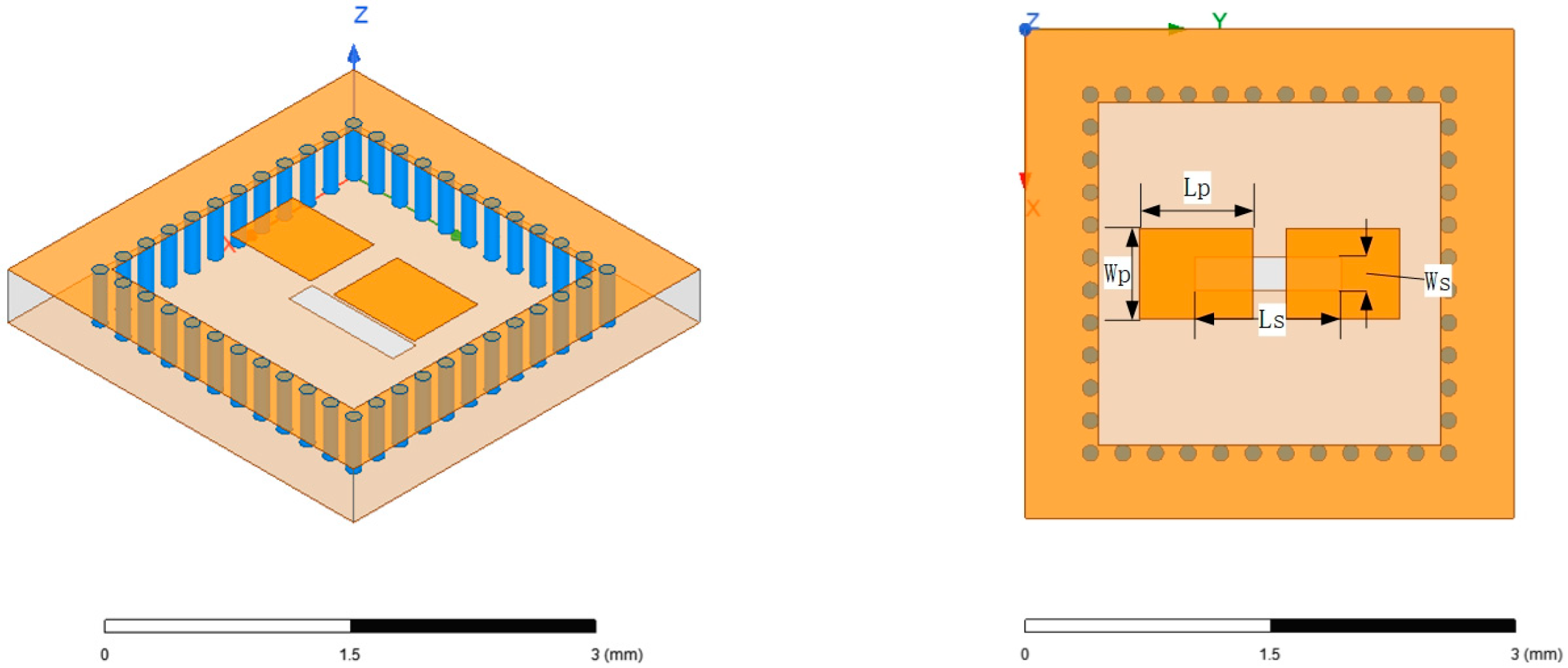








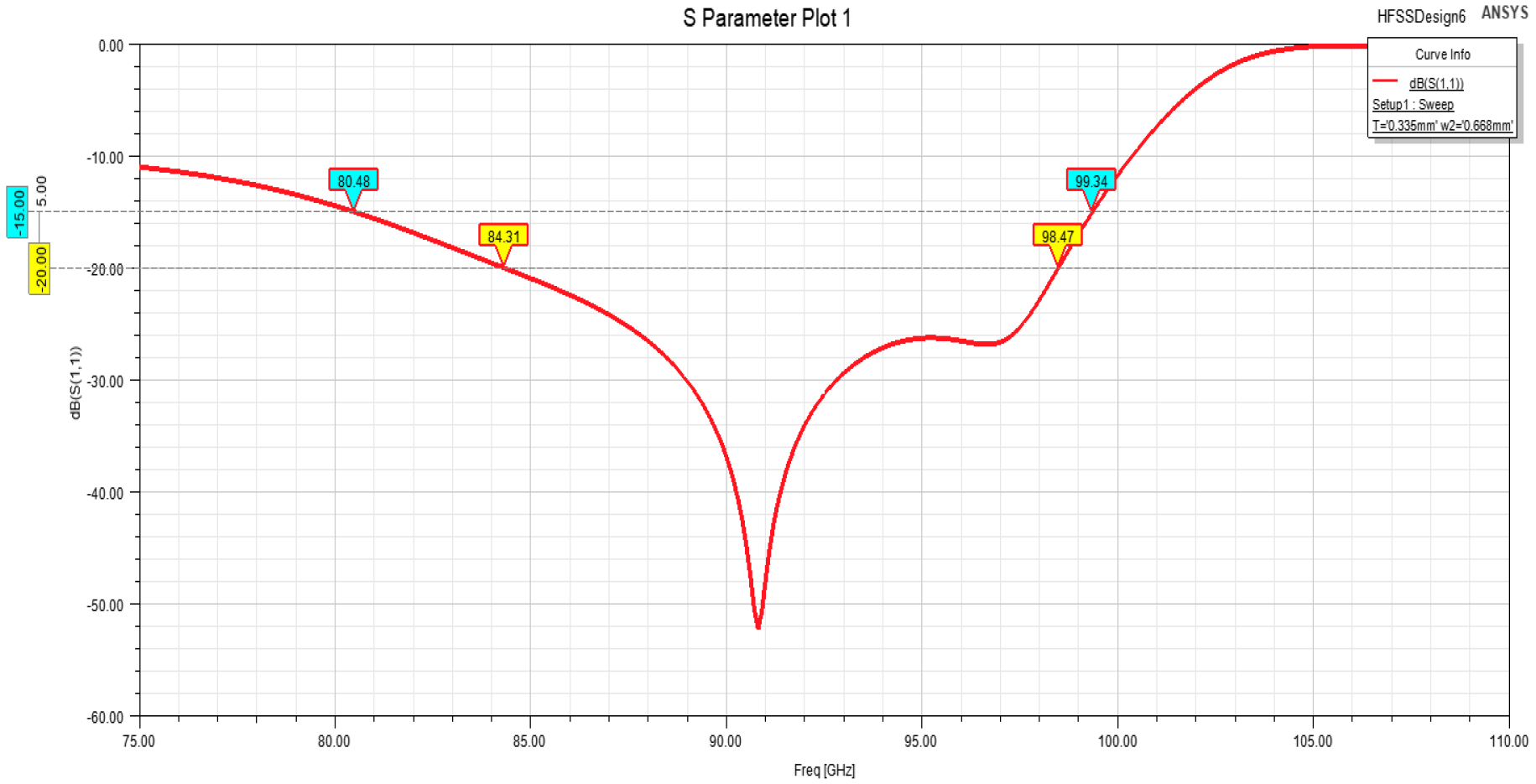









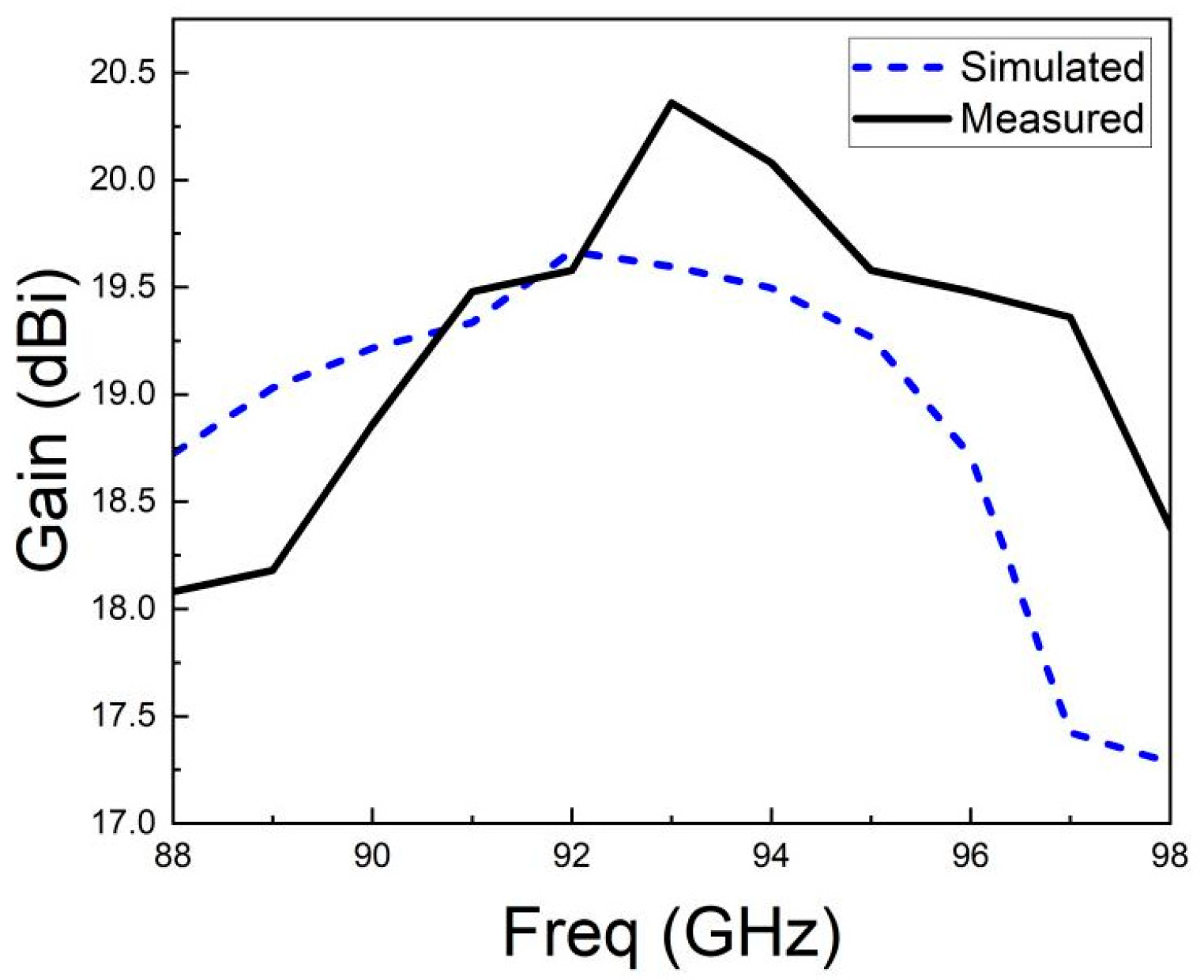

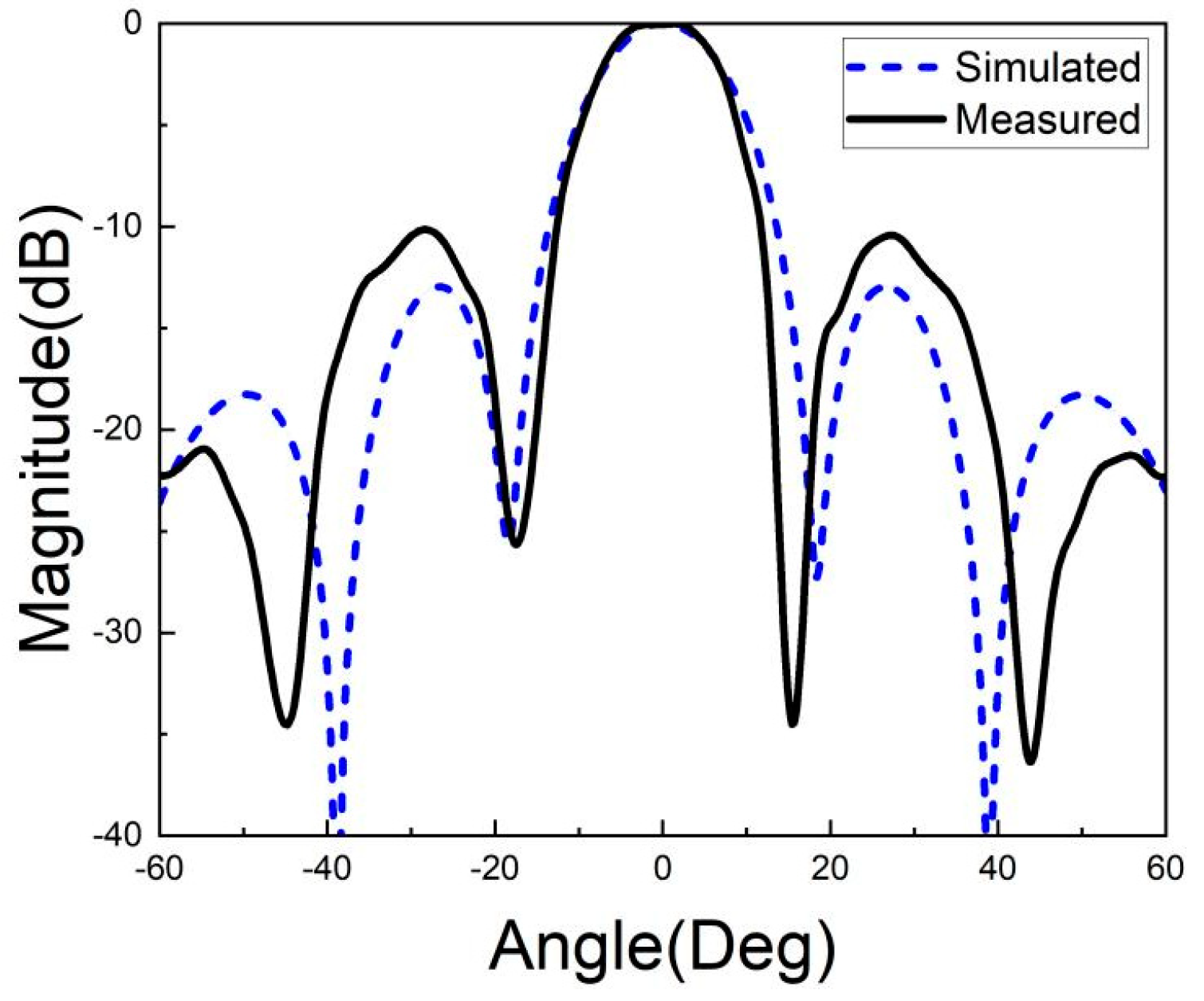



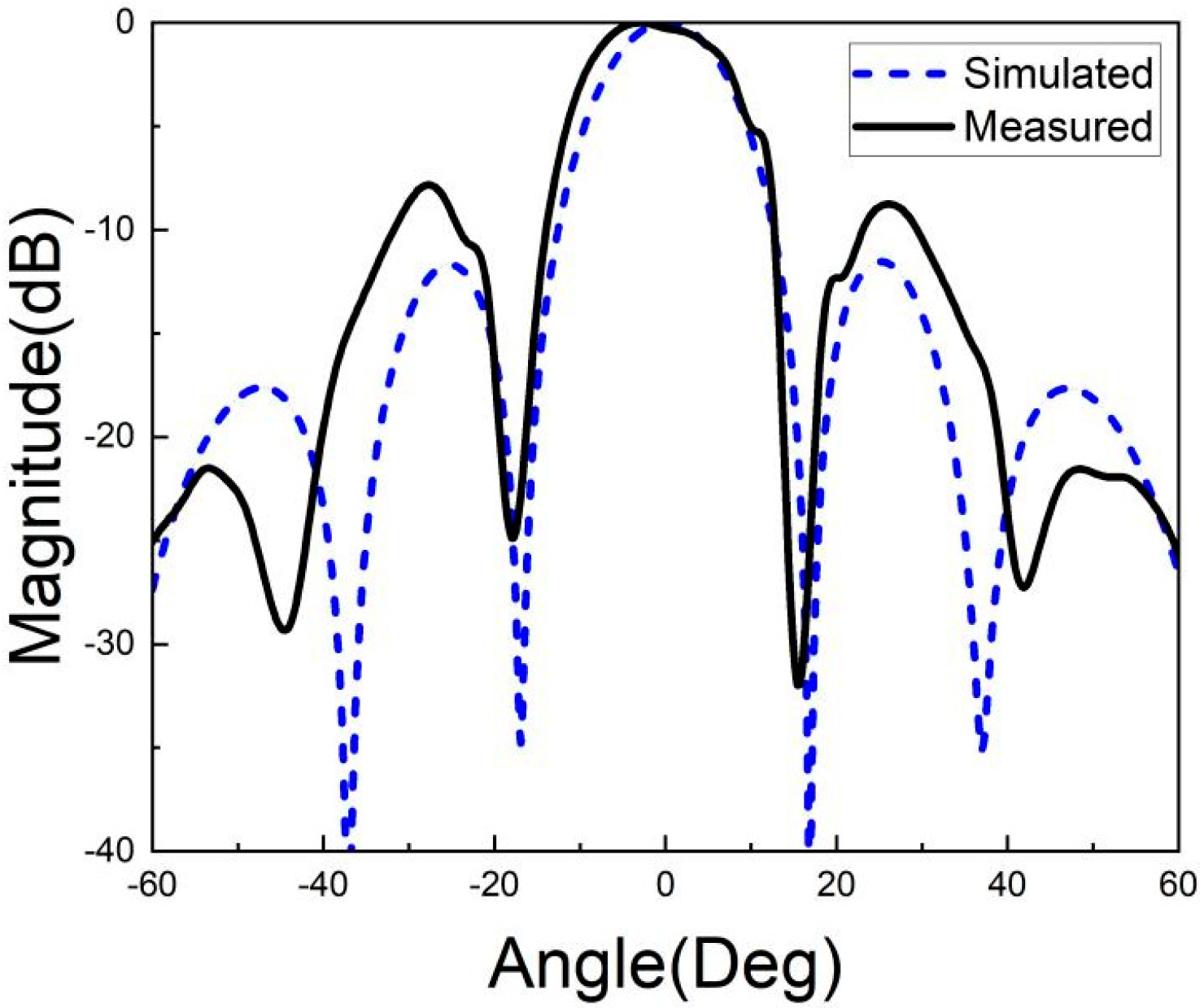
| The Literature | Array Element Number | Array Size (mm) | Operating Band (−10 dB) | Maximum Gain (dBi) |
|---|---|---|---|---|
| [31] | 4 × 4 | 18.6 × 18.6 × 2 | 57.3–64.0 GHz | 18.2 |
| [32] | 8 × 8 | 21.6 × 21.6 × 1.248 | 87–101 GHz | 22.9 |
| [33] | 8 × 8 | 22.8 × 22 × 0.127 | 94–100 GHz | 21.4 |
| [34] | 4 × 4 | 23 × 20 × 0.76 | 130–152 GHz | 16.3 |
| [28] | 8 × 8 | 32 × 20 × 0.818 | 130.3–145 GHz | 20.5 |
| [35] | 8 × 16 | 32 × 18 × 1.413 | 91.2–96.7 GHz | 24.5 |
| This paper | 4 × 4 | 12 × 12 × 0.9 | 88–98 GHz | 20.4 |
Disclaimer/Publisher’s Note: The statements, opinions and data contained in all publications are solely those of the individual author(s) and contributor(s) and not of MDPI and/or the editor(s). MDPI and/or the editor(s) disclaim responsibility for any injury to people or property resulting from any ideas, methods, instructions or products referred to in the content. |
© 2024 by the authors. Licensee MDPI, Basel, Switzerland. This article is an open access article distributed under the terms and conditions of the Creative Commons Attribution (CC BY) license (https://creativecommons.org/licenses/by/4.0/).
Share and Cite
Teng, L.; Yu, Z.; Zhu, D.; Hao, C.; Jiang, N. Antenna Array Design Based on Low-Temperature Co-Fired Ceramics. Micromachines 2024, 15, 669. https://doi.org/10.3390/mi15060669
Teng L, Yu Z, Zhu D, Hao C, Jiang N. Antenna Array Design Based on Low-Temperature Co-Fired Ceramics. Micromachines. 2024; 15(6):669. https://doi.org/10.3390/mi15060669
Chicago/Turabian StyleTeng, Lu, Zhongjun Yu, Dali Zhu, Chengxiang Hao, and Na Jiang. 2024. "Antenna Array Design Based on Low-Temperature Co-Fired Ceramics" Micromachines 15, no. 6: 669. https://doi.org/10.3390/mi15060669






